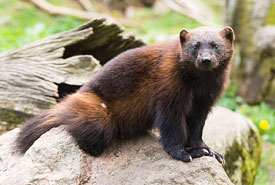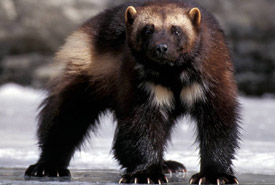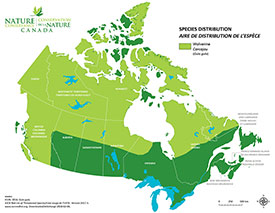
Wolverine (Photo by Jonathan Othén, Wikimedia Commons)
Wolverine
A Marvel Comics favourite and Hollywood darling, Wolverine is a superhero who’s known to strike fast and furiously. In real life, the wolverine displays no less prowess than the action hero it inspired. It has the look of a small bear — furry coat, beady eyes, round face and ears. The wolverine’s padded paws act like snowshoes, insulating its feet and enabling it to tread lightly on snow.
But if you’re so lucky as to spot one, do keep your distance. This species has a fearsome reputation. When threatened, wolverines are not afraid to use their sharp teeth and semi-retractable claws.
Rarely are these beasts seen. They are solitary, shy animals with a big home range (50-400 square kilometres for males and 230-1,580 square kilometres for females). Researchers are just beginning to understand their distribution, population genetics and land use. Due to their sensitivity to disturbances in their habitat, they are considered an indicator species that signals the overall health of their ecosystem.
The beast that lives up to its name
The Latin name for wolverine is Gulo gulo, which translates to “glutton.” This may point to the species’ feeding habits. Wolverines eat whatever may cross their path, from carcasses, to mice, to berries and plants. This species may even prey on hibernating animals or steal from a bear’s cache.
Understanding this stealthy carnivore
In recent years, researchers have studied the wolverine’s distribution and how connected populations are in British Columbia, Alberta and along the Continental Divide across U.S. borders. Darkwoods, a Nature Conservancy of Canada (NCC) property, served as a sampling site for researcher Doris Hausleitner’s team. The researchers suspect wolverines also actively use the Frog Bear Conservation Corridor (also shared by grizzly bears and other species), which is nestled between the Purcell and Selkirk mountains.

Wolverine (Photo by Daniel J. Cox, Natural Exposures)
Tony Clevenger, a research scientist with the Western Transportation Institute of Montana State University, studied the species in Yoho, Banff and Kootenay national parks, as well as the central and southern Canadian Rockies. Using camera-based and genetic sampling, Clevenger’s team detected very few wolverines on the Alberta side, in comparison to BC. Overall, both Hausleitner and Clevenger found higher wolverine density in the north than in the south, and more wolverines in protected areas sheltered from human activity.
Over in Manitoba, wolverine populations appear to be doing well, perhaps in part due to high numbers of prey (beavers) and fewer trappers in wolverine territory. Dean Berezanski, a provincial furbearer biologist with the Province of Manitoba, says there has been some genetic research focussed around this species in the past 10 to 15 years. He’s getting reports of more wolverines farther south in the province. This dispersal, in addition to the species’ return to its traditional range, indicates a healthy wolverine population.
Conserving wolverines with sound science
Other pressures the wolverine faces include habitat fragmentation, human infrastructure and recreational activities. The hope with all this research is that the data gathered will paint a better picture of where wolverines live and how many there are. This information will help guide their management and related landscape-scale conservation.
Want to support wildlife species and their habitat? With your donation, you are accelerating the pace of conservation and helping find solutions to the twin crises of rapid biodiversity decline and climate change. Learn more >






